River Murray – Marine Safety Advice
Safety tips for operating a vessel on the River Murray after a high flow event
If you are operating a vessel:
- Don’t go out if the conditions are hazardous.
- Conditions may have changed since the flood event.
- It is recommended to wear a lifejacket. Requirements regarding the wearing of lifejackets continue to apply on the River Murray. Use our lifejacket checking tool to see which lifejacket you need for the type of vessel you are operating.
- Check for hazards such as floating debris like tree branches before operating a vessel and continue to take extra care.
- Be aware that some hazards may still be just below the surface of the water or snagged. Take extra care and travel at a safe speed suited to the conditions.
- All vessels must travel at a safe speed giving you enough time to stop or turn your vessel to avoid any sudden danger such as collision, injury to people or damage to things.
- It is a good idea to check for any hazards if you are planning to water ski
- Where a waterway has no speed limit, you must always travel at a safe speed
- Remember:
- 4 knots within 50 metres of swimmers and unpowered paddlecraft craft such as a canoe, kayak or paddleboard.
- 4 knots within 30 metres of any other vessel that may be affected by your wash.
- 4 knots within 100 metres of a ferry crossing.
- Keep 100 metres clear directly behind people being towed by another boat.
- Reduce your speed around the riverbank.
Specific rules if operating a vessel in the Lower Murray Reclaimed Irrigation area (floodplain of the River Murray between the townships of Mannum and Wellington) to protect these levees:
- A person must not moor, anchor, attach, or secure a vessel to an engaged levee
- Do not exceed a 4-knot speed limit within 250 metres of an engaged levee
River Murray Ferries
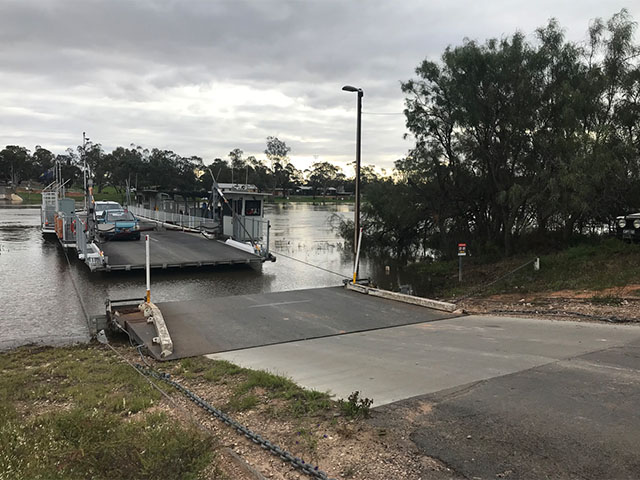
All ferries across the River Murray are operating.
Stay up to date with ferry locations and operational status here.
Ferry landing points
River Murray ferries latch to a landing point on the ramp which allows vehicles to safely enter and exit the ferry. With high flows on the River Murray causing flooding and rising water levels, ferry landings can be moved up and down the ramp within a range to enable ferries to continue to operate. When water levels rise over the highest landing point, a ferry cannot land safely, and the ferry will be closed. Every ferry crossing has a different highest landing point ramp height depending on the roads and terrain.
The diagrams below demonstrate ferry landings as water levels rise.
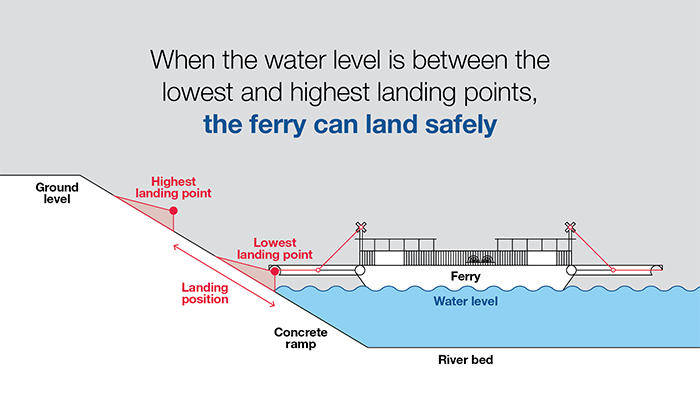

Example of a ferry landing locking mechanism
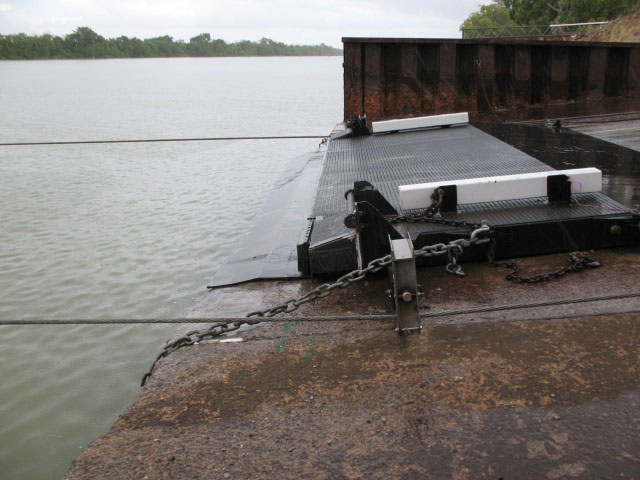
Ferry landing point

Ferry approaches the landing point chained down on a concrete ramp
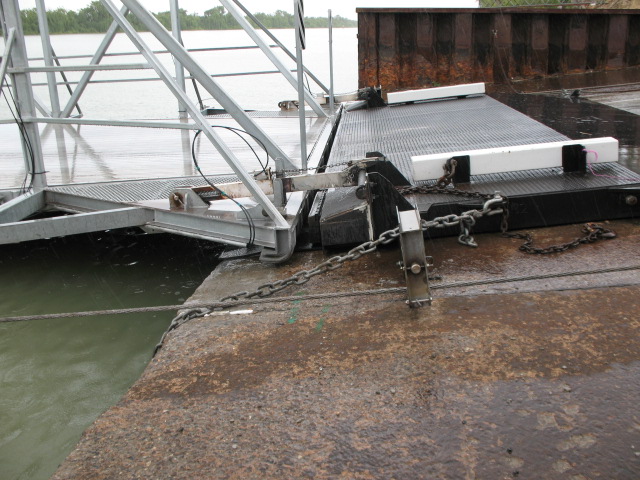
Ferry latches to the landing point - duo latch mounting bars ensure the ferry is secure for loading and unloading vehicles
River users approaching ferry crossings
During a high flows the rules around approaching a ferry crossing remain the same, please note if the river is wider due to rising levels, vessel operators need to continue to manoeuvre towards the available channel in the middle of the crossing to cross safely.
Rules for boats approaching ferry crossings
- When approaching a ferry crossing, reduce speed to 4 knots within 100 metres and maintain it for 100 metres on the other side of the crossing.
- Never pass in front of a ferry.
- Never pass close to a ferry that is crossing the river. The heavy steel cables used to guide the ferry may be close to the surface and can seriously damage a boat. Stay at least 30 metres away from the ferry.
- Always slow down and if necessary stop and wait for the ferry to reach the bank before crossing.
- If your vessel is fitted with a horn, a four- to six-second blast should be sounded when approximately 500 metres away from the crossing.
- If your vessel is not fitted with a horn then approach the ferry with caution.
- The ferry operator will let you know if the ferry is not leaving the river bank by displaying a green flashing light when at rest on either side of the river. At Mannum where there are two ferries, proceed when either one or both are showing their green flashing lights.
- At the 100-metre mark, vessels should be manoeuvred towards the available channel - see diagram below.
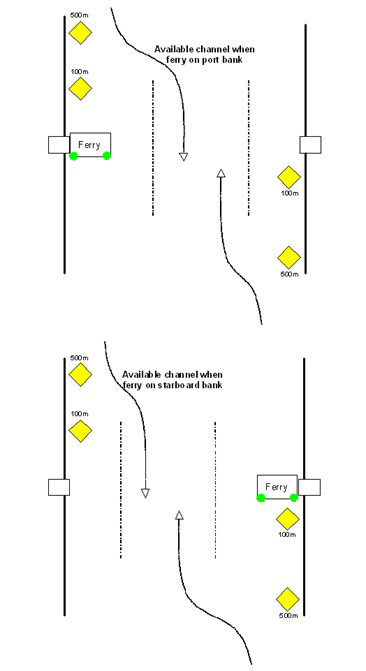
Rules for ferry users
- There is a 10 km/h speed limit on ramp and ferry.
- Wait until directed by the ferry operator before moving your vehicle onto the ferry.
- Apply handbrake once the vehicle is in position.
- Supervise children at all times.
- Keep clear of the ferry operator's walkway and ferry machinery.
- Do not hinder or obstruct the ferry operator.
- If asked, provide correct, name, address and gross vehicle mass to the ferry operator.
- At night drivers are requested to switch to parking lights only to avoid blinding the ferry operator.
There are penalties for not adhering to these rules.
All emergency vehicles that arrive at a ferry crossing displaying emergency beacons or sounding sirens are given priority to board the ferry.
General tips for marking submerged hazards
- Buoys can be used to mark submerged hazards or snags (e.g. – submerged jetty).
- Recommended buoy to use - yellow in colour and sized around 200mm (8 inches) in diameter.
- Allow for enough line on the buoy.
- Please report any submerged hazards you mark via our Marine Safety SA Hazard reporting tool.
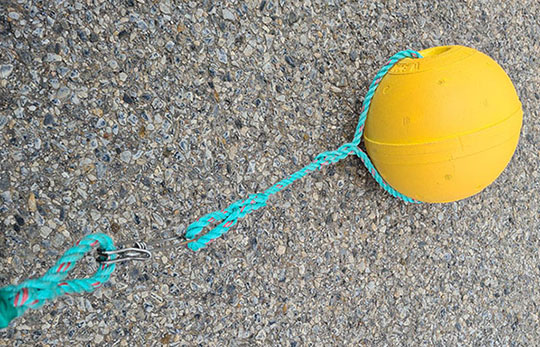
Example of a buoy and line.
Stay informed
- Report marine navigational hazards / marine safety concerns
- Ferry operational status / follow us on Department for Infrastructure and Transport Facebook or Twitter
- Check the SES website at ses.sa.gov.au/rivermurray
- Call the SA Emergency Infoline on 1800 362 361
- People who are deaf, or have a hearing or speech impairment, can contact the SA Emergency Infoline via the National Relay Service on 1800 555 727 (TTY users 1800 555 677)
- For weather warnings and forecasts visit www.bom.gov.au.



